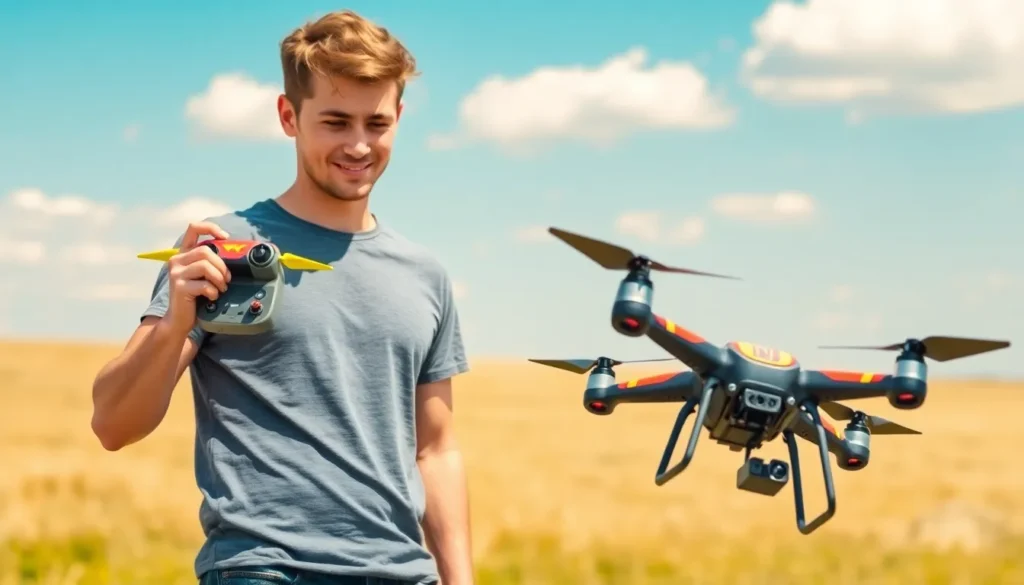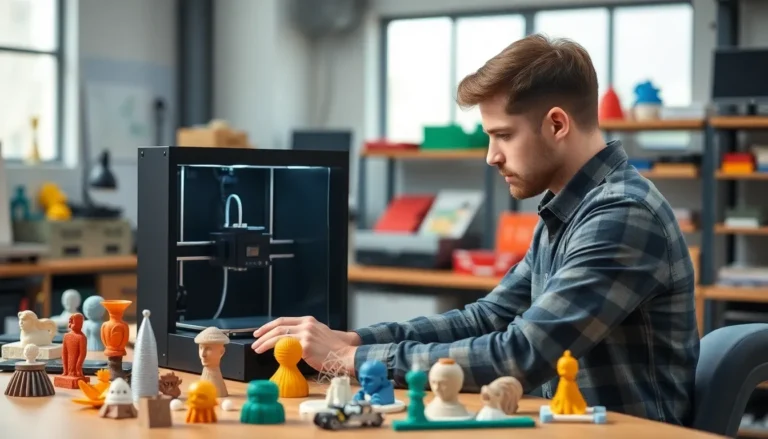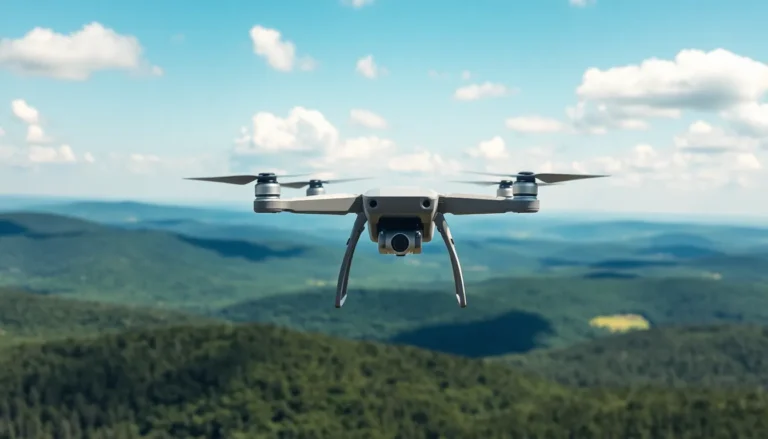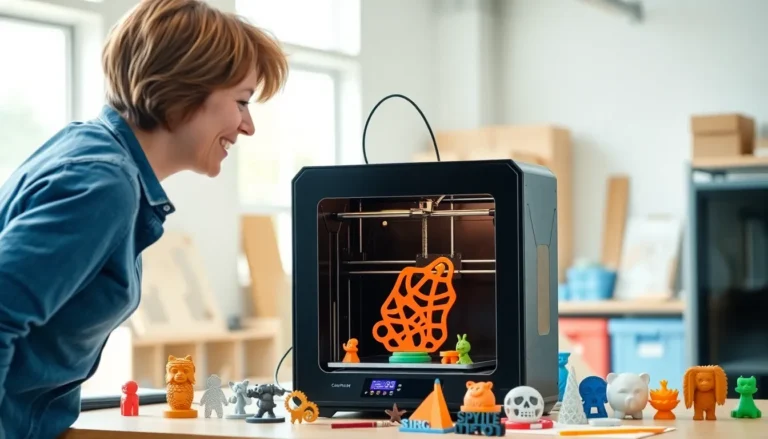Drones are the cool gadgets that make everyone feel like a kid again. Whether it’s capturing breathtaking aerial views or just buzzing around like a high-tech bee, these flying wonders are taking the world by storm. For beginners, diving into the world of drones can feel a bit like trying to assemble IKEA furniture without the instructions—overwhelming and slightly chaotic.
Table of Contents
ToggleOverview of Drones
Drones represent a fascinating blend of technology and creativity. They serve various purposes, from photography to leisure activities.
What Are Drones?
Drones are unmanned aerial vehicles (UAVs) that operate via remote control or autonomous flight. Equipped with cameras and sensors, these devices capture images and gather data from above. Many hobbyists enjoy flying drones for recreation, while professionals utilize them for tasks like surveying and monitoring. Their versatility makes drones an appealing choice for beginners eager to explore aerial perspectives.
Types of Drones for Beginners
Several drone types cater to beginners. Quadcopters present a popular option due to their stability and ease of use. These four-rotor drones offer a forgiving learning curve. Camera drones also provide an excellent choice, enabling users to capture high-quality images and videos. Additionally, toy drones serve as an affordable and accessible entry point for novices. Each category allows new pilots to gradually enhance their skills and confidence while enjoying the thrill of flight.
Choosing the Right Drone
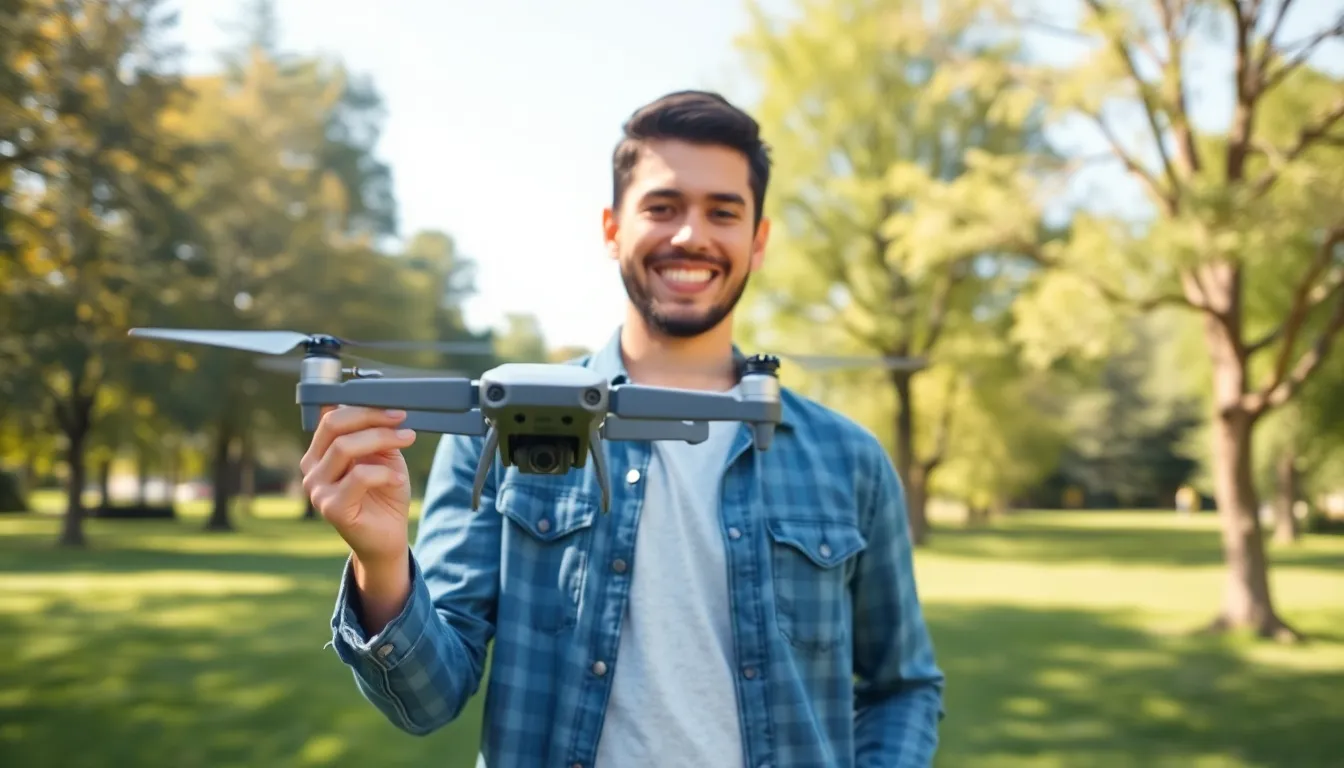
Selecting a suitable drone involves considering various factors that align with user needs and skills. Beginners should focus on essential features and budget options to ensure an enjoyable experience.
Key Features to Consider
Camera quality ranks as a crucial feature for many users. Look for drones equipped with high-resolution cameras if aerial photography captures your interest. Flight time significantly impacts usability; models offering at least 20 minutes of flight time provide better experience for beginners. Additionally, consider range and ease of control. Drones with user-friendly controls enhance the learning curve. Safety features, like altitude hold and headless mode, simplify operation. Check user reviews for reliability and overall performance to make an informed choice.
Budget-Friendly Options
Affordable drones exist for newcomers seeking to enter the hobby without overspending. Models under $200 often provide decent performance for beginners. Brands like Holy Stone and Potensic offer quality drones that balance features and cost. Depending on the desired experience, selecting a toy-grade drone for indoor flying or a more robust model for outdoor adventures can tailor the experience. Additionally, many manufacturers run promotions, so saturating the market with options might result in finding deals. Always consider local retailers as they may provide better pricing than online vendors.
Getting Started with Drones
Drones offer exciting opportunities for exploration and creativity. New users can quickly immerse themselves in the world of aerial flight.
Setting Up Your Drone
Check the user manual for specific assembly instructions. Ensure batteries are fully charged before flight. Adjust settings to match preferences, including camera configurations and flight modes. Calibrate the drone according to the guidelines, which ensures optimal performance. Initiate a pre-flight checklist, examining propellers, connections, and remote controls for any issues. Consider practicing in open areas to minimize obstacles. Familiarize oneself with local regulations regarding drone use before taking off.
Basic Controls and Flight Techniques
Mastering the basic controls is essential for a smooth flying experience. Use the left joystick to control altitude and rotation. Employ the right joystick to maneuver side to side and forward or backward. Practice hovering for stability in flight. Learning to navigate in headless mode can simplify control for beginners. Utilize gentle movements during early flights to prevent sudden shifts in direction. Implement safe landing techniques to avoid damaging the drone upon descent. Familiarity with these skills builds confidence for more advanced maneuvers.
Safety and Regulations
Safety and compliance with regulations play a crucial role in drone operation. Understanding these aspects prevents accidents and ensures responsible usage.
Understanding Drone Laws
Drone operators must familiarize themselves with local laws governing airspace. The Federal Aviation Administration (FAA) in the U.S. outlines essential regulations, such as registering drones weighing over 0.55 pounds. Knowledge of no-fly zones, including airports and military facilities, is vital. Many states also impose specific guidelines on drone use, particularly in populated areas. Staying informed about these rules helps prevent legal issues while flying, ensuring responsible and enjoyable experiences.
Tips for Safe Flying
Practicing basic safety precautions enhances the flying experience. Always conduct a pre-flight check, ensuring the drone is in optimal condition. Battery levels should be sufficient for the planned flight duration. Selecting open areas away from crowds mitigates the risk of accidents. Maintaining visual line-of-sight with the drone allows for better control during flight. Additionally, avoiding adverse weather conditions contributes to safer operations. Respecting privacy by not flying over private property fosters goodwill within the community.
Maintenance and Troubleshooting
Regular maintenance ensures drones operate smoothly and effectively. Proper care can lengthen a drone’s lifespan and enhance performance during flights.
Regular Maintenance Tips
Check the propellers frequently for any signs of damage or wear before each flight. Clean the drone’s exterior to prevent dirt buildup that could affect components and sensors. Inspect battery connections regularly to ensure a secure fit and optimal power delivery. Store the drone in a cool, dry place to avoid moisture damage. Perform firmware updates as manufacturers release them to benefit from improved functionality and security. Lastly, consider calibrating the drone’s compass and sensors each time before flying to enhance accuracy and stability.
Common Issues and Solutions
Battery issues often surface, leading to short flight times. Swapping out old batteries with new ones resolves this. If the drone drifts during flight, recalibrating the compass typically corrects this behavior. Connectivity problems with the remote controller can occur; resetting the controller and pairing it again often helps. Unresponsive controls may suggest a need to check for firmware updates or recharge the batteries. Lastly, camera malfunction might indicate a need for cleaning the lens or ensuring connections are intact. These quick fixes can enhance the flying experience significantly.
Drones open up a world of adventure and creativity for beginners. By choosing the right model and understanding essential features, new pilots can embark on an exciting journey into the sky. Mastering basic controls and safety practices not only enhances the flying experience but also builds confidence for more advanced maneuvers.
Regular maintenance and awareness of local regulations further ensure a smooth and responsible operation. With the right preparation and a spirit of exploration, anyone can enjoy the thrill of flying and capture breathtaking aerial imagery. Embracing this technology can lead to endless possibilities and unforgettable experiences.

